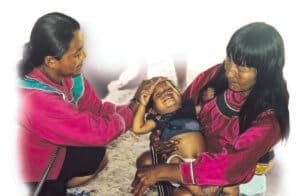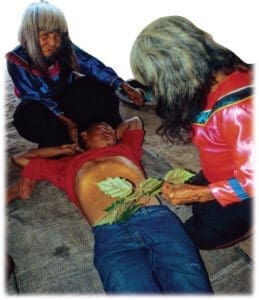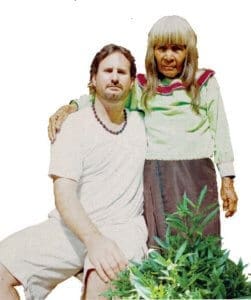A Source Point for Health and New Drug Compounds
© 2006, Jerome R. Black, Ethnobotanical Researcher for Herbs America and Amazon Therapeutic Laboratories
 The old Shaman pointed out the discrepancy between herbs with similar doctrines and morphological signatures “This plant is the third brother to the little one,” he said in his Panoan dialect, noting the differences in two similar species as if they were related by blood.
The old Shaman pointed out the discrepancy between herbs with similar doctrines and morphological signatures “This plant is the third brother to the little one,” he said in his Panoan dialect, noting the differences in two similar species as if they were related by blood.
As I listened carefully for any nuance in his botanical parlance, it was revealing for many reasons: the Shuni were isolated forest-dwelling people and their familiarity to each herb’s medical action was certain. Their knowledge of taxonomic variances was impressive considering they are located more than 300 miles from the nearest city and no foreign botanist has worked in this region of the Amazon before.
 “This medicine is our primary antibiotic; this herb is applied topically; this one, outstanding for menstrual complaints, muscle cramps, and any type of sciatica.” He bent low and softly picked three leaves from each plant. Although the translation came slowly into Spanish, thanks to an astute grandson who had been taught by missionaries, these healers were fastidious in the application of their herbs. Whether it was the outer reaches of Brazil, Bolivia, or a long Cessna flight from Peruvian towns onto grassy airstrips and then days in a dugout canoe going upriver, the farther afield we traveled, the more integrity and adherence there was to the original knowledge and authentic application of the herbs.
“This medicine is our primary antibiotic; this herb is applied topically; this one, outstanding for menstrual complaints, muscle cramps, and any type of sciatica.” He bent low and softly picked three leaves from each plant. Although the translation came slowly into Spanish, thanks to an astute grandson who had been taught by missionaries, these healers were fastidious in the application of their herbs. Whether it was the outer reaches of Brazil, Bolivia, or a long Cessna flight from Peruvian towns onto grassy airstrips and then days in a dugout canoe going upriver, the farther afield we traveled, the more integrity and adherence there was to the original knowledge and authentic application of the herbs.
The Shuni understood ethnopharmacology from a clinician’s point of view. Although it was obscured by their particular idiosyncrasies and a rare language (spoken by less than 400 people in the world), I was careful to note those subtle indications which told me they knew precisely what they were talking about. Here, where few elders were left, hidden by the jungle’s lush canopy, was a proprietary medical system—a gift to the world.
Nowadays, wherever I go, there is a diminishing populace and elders are in decline. To document the exact use of their remedies and the cultural values behind each herb was an urgent matter for me. Ten years from now, it will be difficult to obtain first-hand accounts of how to utilize these natural drug compounds. In many cases, the most knowledgeable healers are indigenous women herbalists in their late seventies, eighties, and nineties. They have kept the use of phytomedicines alive by their adherence to traditional village lifestyles, often with entire songs dedicated to how to use one plant.
The Amazon Basin and the surrounding Andes mountains are a treasure trove of allied medicinal plants that have been forged into an organized pharmacopeia that rivals western medicines. The verdant riches of the canopy hide more than two thousand known medicinal plants. Bioprospectors assume there are thousands more. Over the last 12 years, our company has set its focus on the top 120 herbs. My job was to find a sustainable source of herbs, set up alliances with growers in indigenous villages, and ensure the correct post-harvest treatment as they reach our facility in Peru and finally to the USA.
What is more crucial for western markets are the clinical studies on these herbs. To verify these studies, I regularly visit more than 20 universities throughout South America and numerous institutions and biomedical research centers. I forge alliances not only with indigenous groups but frequently visit health departments, pharmacologists, presidents or authorities of indigenous reserves and demarcated territories set up for logging or oil interests. I sometimes pay enormous bribes to get into a territory, and even more money to get the herbs out. In the interim, I logged in more than 10,000 miles in the splintery seat of a dugout canoe. Today, our company networks with more than a dozen traditional healers and another 50 university-trained medical doctors throughout Latin America—all who employ traditional Amazon medicines in their practice.
By many accounts, Amazon medicines tend to be far more biologically active than commonly known western herbs. Some of the clients we serve in the USA claim they are more acute in their actions and felt more rapidly and energetically. There is some scientific basis for this, and it has to do with biological diversity which gives rise to an increase in primary metabolites during the growth of the plants. Remarkably, 70 percent of what my indigenous grandmothers are doing medically in the jungle are proven out in the laboratory studies.
But there had been a missing link in the pharmacopeia’s connection to the west all these years. Amazon people never had a written language to confer and archive medicinal knowledge in a similar fashion as Chinese or Ayurvedic practitioners had done over millennia. Rather, upon the onslaught of European arrival to South America, astute medical healers of the Amazon and Andes Mountains were banished or fell ill. Others were killed outright or pushed to alter their traditional habits.
For this reason, I work as far as I can from acculturated peoples. This is where the magic of ethnobotany and a unique cosmo-vision of the world survives. Here, my teachers reveal that they once had highly attuned techniques for passing on botanical knowledge. I would surmise by observing pre-Columbian traditions from Argentina to Central Mexico, that there was once a formal system of training in botanical schools that were set up throughout the Amazon basin and Andes mountains.
Today, our company helps piece together remnants of this great green pharmacy. Not only do we collect herbs and press voucher specimens, but we back up each herb with sound studies and empirical trials that point to a long history of use. As a final measure, to guarantee the success of each herb in the North American market place, we select only the botanicals that have risen to the top of modern-day pharmacy in South America. Our product line offers herbs that are safely used by millions throughout South America and Europe. It is from these botanicals that we fashion our formulations that were first learned in the heart of the jungle.

“Ten leaves placed on this muscle grouping, wait, ….there. Pull it off. Now drink this infusion.” My adopted grandmother bent to the dirt floor and coddled the young child who wept profusely from an unknown “susto”—a “bad spirit”— she said, that had taken up “residence” in the child’s lower stomach.
The description, at first, I thought, was simple and unsophisticated, but then it all made sense to me. She described the “bad wind” that had made the child’s “stomach collapse.” In her description was an understanding of the illness. Even without the diagnostic tools, we have in the west, her familiarity with healing modalities gave a diagnosis which was not far from the known etiology for the disease.
As I watched her work, I documented the treatment and realized she had made a small discovery that was scientifically exciting. The herb she was applying produced an instant histamine reaction. Huge red welts rose up on the stomach of the child. It looked horrible for five minutes; then the welts subsided as fast as they had appeared. The child stopped crying, yawned, and immediately fell into a peaceful sleep in the arms of its mother. Perfect, I thought. I had just witnessed a multi-drug histamine injection. She simply gave the child a very primitive form of injection, pushing the histamine drops into the skin by the point of the native species of black nettle (Urtica sp). What else would serve for an Amazon healer before the arrival of stainless steel needles?
Once injected, the mast cells—the histamine receptors in the skin—were stimulated and allowed the body to begin a chemical reaction. Mast cells are known to release prostaglandin in response to the activation of stretch receptors, and the histamine found in nettles acts as a local hormone that modulates the immune response. Stimulation of the mast cells is also integral to the innate immune response and important for clearance of bacteria and viruses. Amazon black nettles are also known to contain serotonin and acetylcholine—two potent neurotransmitters. From this simple injection, the body could then produce its own natural antihistamines and other endogenous compounds which could possibly alleviate colic, gastric acid, internal inflammation or perhaps a bad case of gastritis or bloating, and then help a person to sleep or relax.

Like other healers I have watched in far-flung regions of South America, the methods of injections for indigenous botanical drugs are as creative and even more varied as we find in the west. Many of the herbs are administered through the eyes, ears, nose, and by merging the botanical drugs directly in the bloodstream by way of a hole burnt in the skin. This is the case especially for Sapo (frog sweat) which is rich in peptides and new alkaloids and can regulate fertility in women who are infertile. So how could our indigenous grandmothers in the jungle be expected to articulate the scientific aspect of their medicine in a way we would understand? Or be appreciated for what they know when they use their own terminologies?
“Cures colic in babies and arthritis in older people, Ishiping Rao,” my yeshun or grandmother said, continuing the treatment. She was Yeshun Leopauldina, a renowned village healer, but known only along one tributary of the Amazon. I’ve visited her for several years now. She often sings as she heals. And it occurred to me that singing the medicine songs was important as a method of preserving the knowledge—easier to remember and more fun for children to learn.
“Beautiful herbs that will prick you and burn you, but cherished medicines, bring them to me—Nakon Rao, good medicine,” she sang. She’s getting on in age. As a trained herbalist of 80 years old, she is a treasure of medicinal knowledge for the Shipibo Conibo. Today, a road has recently been punched into her village, signaling the sure demise of the traditional ways. But the money she earned from our company during our various trips, has put a tin roof on her house and her stone-grinding tools have been replaced with imported Brazilian corn grinders. Her once bare and knotted feet, with which she slithered so perfectly through the wet forest soils (at four feet eight inches, she is like a lithe fairy), have become cumbersome under the slap of flip flops and rubber boots.

Many people ask about the direction of indigenous people and their levels of self-determination. As anywhere, some people have drive, ambition, pride, and like everywhere, there are others that are content with almost nothing but good company. No matter what the cultural moors, nor the levels of harshness or bliss found in the jungle, our first priority should be to protect intellectual rights and jungle habitat. It is important to recognize indigenous people for their medical invention, and realize each tribe has a valuable and well defined green pharmacy. It is imperative that we respect their culture and pay tribute to their intellectual property and to set up a system of royalties or ethical commerce. Ultimately, we must step back and allow each clan, with their various levels of organization, the self-determination in choosing a path for their future. While the survival of their bloodlines is certain, survival of their heritage and cultural values is not. Together, let’s take these important steps towards creating socially equitable exchange of goodwill for supremely good medicine.
Here in the Amazon jungle, our company has set up alliances and endeavors to procure the finest, freshest botanical drugs derived from sustainable resources with an ethical bent to serve all of our relations. Practitioners revel in the fast-acting efficacy and immediate response reported by clients in the use of many of our formulas. Clinicians swoon at the thousands of studies that back up these herbs. All of them, with precise chemical profiles and information, become validated by Western standards.
Today we have seen the origins of this medical system as it sprang forth from the healing arts of renowned herbalists and astute practitioners of science. It took thousands of years to define, and in many ways, much of it remains elusive, locked away in the cosmology, the mythology, and the sheer remoteness of the Amazon biospheres.
REFERENCES
- Cultural references and ethnobotany of the Amazon
- Field Notes and Personal Communication Jerome R. Black 1994-2006
- Behar J., Normal anatomy, histology, and physiology of the upper gastrointestinal tract. In: Molinoff P., ed. Peptic Ulcer Disease: Mechanisms & Management. Rutherford, NJ: The Healthpress Publishing Group, Inc; 1990: 1-36.
- Lampkin T.A., Ouellet D., Hak L.J., Dukes G.E., Omeprazole: a novel antisecretory agent for the treatment of acid-peptic disorders. DICP Ann Pharmacotherapy. 1990;24:393-402.
- Massoomi F., Savage J., Destache C.J., Omeprazole: a comprehensive review. Pharmacotherapy. 1993;13(1):46-59.
Maton PN. Omeprazole. N Engl J Med. 1991;324(14):965-975. - Vander A.J., Sherman J.H., Luciano D.S., Human Physiology: The Mechanisms of Body Function. 4th ed. New York, NY: McGraw-Hill, Inc; 1970.
- Dr. Ronald Hoffman from the ACAM President of the American College for Advancement in Medicine (ACAM).

Reader Interactions